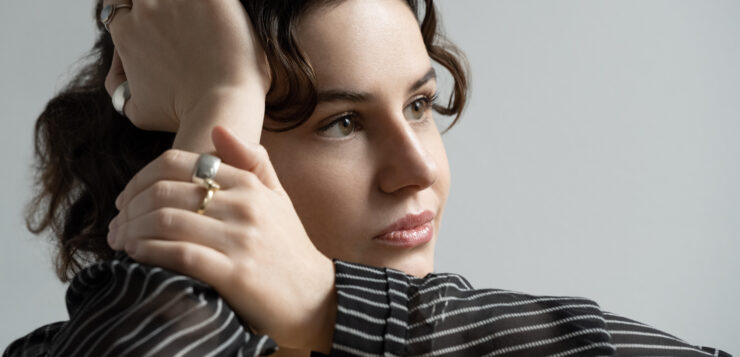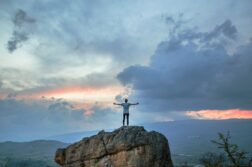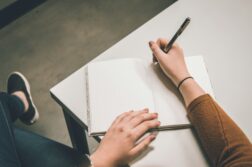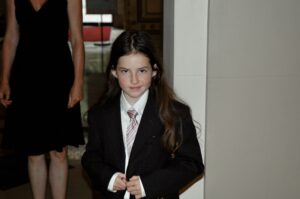
The Kinsey Scale charts queerness in thick, stacked blocks along an x-axis, skyscrapers of identity. The scale ranges from zero for completely heterosexual to six for completely homosexual with everything else in between. I have always experienced my sexuality like a wave or a season, something closer to the earth and harder to measure. It’s not one half of every second. It’s seasonal affective disorder. Allergies every spring. The need to swim during the warm months. It shifts with the tide, with the movements of the planets and the moon. And every time I think I know myself, I change.
At different points in my life, I have worn my hair short as a boy’s and long, down my back as a girl’s. I’ve called myself Francesco and Francesca, Ella and Beck. I’ve worn boxers and thongs, baseball caps and crop tops, bikinis and swimming trunks. Everywhere I go, I have belonged and not belonged. Largely, I have been okay with this discordance; I have accepted it.
But, during the height of the COVID-19 pandemic, living with my then-boyfriend, I began to feel that I had lost my bisexuality, like a favorite sweater forgotten on some subway train. I had felt estranged from my queerness before, by default of being in a straight-presenting relationship, but I had always been able to feel secure within queer spaces. Now, in isolation, I began to miss that part of myself, which I didn’t think was possible.
When my boyfriend and I broke up, it wasn’t because he was a man. It wasn’t because I’m not bisexual. It was because, after five years, we had become different versions of ourselves, yearning to explore our own interests and desires, and we found that these no longer overlapped like they once had. It was heartbreak, of course. But at the same time, it seemed to me like we had learned to be more ourselves. We had learned it, in many ways, from each other, and from the strange year of isolation we spent together.
In robbing us from each other, isolation robbed us of ourselves. The way we are allowed to be only when we travel in packs or pairs, the selves we need help digging out, unburying. It is not the first disease to whittle away at our pride, to make us wonder how we can face the world, us being who we are, the world being how the world is.
Of course, we needed isolation. We needed it to keep us, and each other, safe. And, maybe, we needed it in another way. Maybe we needed it because it forced us to look deeper at ourselves. At the lives we were leading and the communities we depended on. And just as important, who we are when we are alone.
I missed the parts of me that I no longer seemed to have access to, the self I could only be around other queer people. I missed June, that fleeting sense of belonging, like Gretel finding the breadcrumbs she left for herself, following them home. I missed the time when June and I swarmed the streets of lower Manhattan feeling bulletproof and ravenous, the smell of garbage, the suck of an afternoon cocktail, the buzz of last night’s hangover with music playing: You can dance, you can jive.
I knew I needed to find a way back to that. To follow the breadcrumbs back home.
When NYC lifted stay at home orders in 2021, I went to Henrietta Hudson, one of the only still-standing lesbian bars in the city. Someone I’d just met had called Henrietta ahead of time, and asked: “Can you take twenty dykes right now?”
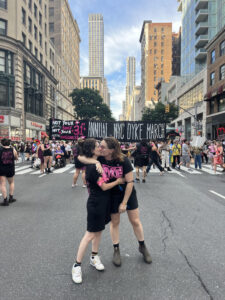
We sat at a long table, and I drank a beer too fast, nervous. I wondered why I was even there, in a group of strangers who all knew each other. I was with members of the Dyke March planning committee, which I’d recently joined, late; it was already June, and these people had been working together since February or March. I’d joined in an attempt at rediscovering community. But, sitting there, I felt like an intruder.
“Honey,” an older dyke to my right said. “Could you pass me the water?”
The endearment in her rough voice. Her certainty, despite not knowing me, that I was like her. Her commitment to loving me, no matter who I was, because of who I was.
The waiter took our drink orders. She had a pair of scissors tattooed on her hand. Someone complimented it, and she told us how a woman had asked last week, if she was a hairdresser. We all laughed. And, suddenly, I could feel the small thread between us: it was a language we all spoke, a secret we’d all kept as children. I relaxed and turned to the people beside me, and got to talking.
I met many of the people I now call my best friends that spring, as we sat in meetings planning the Dyke March. I had sought out this community, inorganic and planned, but I was surprised by the ways it embraced me. I was surprised by the people I met who made me feel at home, like I was family.
The things we did, and discussed, were trivial: who hooked up with whom, who had drama with their ex, what feuds erupted that week. We glanced up at passersby’s and guessed if they were queer. We checked out the same girls. But there was more to it than that, something underneath. Months into our friendship, a friend of mine realized she had no idea what one of our best friends did for work. In a way, it was damning. Why did we never talk about our nine-to-five lives, our career goals? But in another way, it was what made us special: when we were together, we lived in our own world, a world that revolved around queerness. When we left each other, we returned to the colorless world of presumed heterosexuality and corporate America, a fraction of ourselves missing.
And then there was the way we could talk about shame. The way it hung behind so many of our conversations. The way I understood when my best friend, who would later become my girlfriend, told me that her parents knew but also didn’t know she was gay. How she could feel what I’d felt the first time I heard the word queer as a slur, coming out of the mouth of someone I loved. To each other, we did not have to explain these things. And, being with her, the world around me quieted. Somewhere inside me, I knew I had been dreaming of her all my life.
It was when I was with straight people that I most realized what I loved about being in the queer community. When straight people talked about their first kisses and first times. When straight people talked about their parents, about introducing their boyfriends. When straight people sat in a bar and did not wonder how they were being read, if they were being clocked. It was not that I was living in fear in Manhattan in 2021. But some part of me was always thinking about who I was. And when I was not with people like me, that awareness was not shared. That part of me, they could not understand.
In 2021, the Dyke March took all four lanes of Fifth Avenue for the first time since 1997. And I was running alongside the beast of the parade, the body of the protest. I stopped at the faces I knew, faces I loved. The people who had planned this, who had led me through the process, who had made me feel welcome. I felt that, maybe once upon a time, they too had been young and afraid, and maybe, sometimes, they still were. I stopped and grinned at them, and they grinned back, and it was greater than a kiss, that feeling. I was running and my heart was racing, and my fist was closed around something hidden in the sand, a memory as old as Patroclus, as old as Sappho: we do not exist in isolation. We are most ourselves when we find each other.

Francesca McDonnell Capossela is a queer writer and Irish American dual citizen. She grew up in Brooklyn and holds a Master’s in creative writing from Trinity College Dublin. Her first novel, Trouble the Living, is about a mother and daughter and is set in 1997 Northern Ireland and 2016 Southern California. It deals with themes of queerness, abortion, and personal and political violence. For more information, visit her website.


